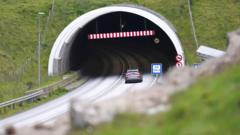India faced a staggering road safety crisis in 2023, with an alarming average of one death every three minutes due to a multitude of factors including reckless driving, inadequate infrastructure, and lack of adherence to safety measures, raising the urgent need for reform.
Alarming Road Safety Crisis: India Confronts a Killing Spree on its Highways

Alarming Road Safety Crisis: India Confronts a Killing Spree on its Highways
Over 172,000 lives lost on Indian roads in 2023 amidst systemic neglect and hazardous infrastructure.
In 2023, India experienced a devastating road safety crisis, with over 480,000 accidents resulting in more than 172,000 fatalities, translating to an average of 474 deaths per day or nearly one every three minutes. Daily newspapers report on heartbreaking incidents—from passenger buses tumbling into gorges to pedestrians being struck by drunk drivers—highlighting a grim reality for Indian society.
Despite an official crash report for the year being pending, Road Transport and Highways Minister Nitin Gadkari revealed these alarming statistics during a recent road safety event in December. Among those killed were 10,000 children, with numerous accidents occurring near schools and colleges claiming another 10,000 lives. The gravity of the situation is further compounded by the unfortunate deaths of 35,000 pedestrians and the disproportionate toll on two-wheeled vehicle riders. Over-speeding was identified as the leading cause of these tragedies, alongside a lack of basic safety measures such as helmet and seatbelt usage, with 54,000 and 16,000 fatalities attributed to these oversights, respectively.
Additionally, road design flaws and a mixture of diverse transport modes— from motorcycles to animal-drawn carts— complicate the already hazardous road environment. Still, experts caution that the crisis stems not just from infrastructure inadequacies, but also human behavior, enforcement gaps, and systemic neglect. The economic toll of these crashes amounts to a staggering loss of 3% of India's annual GDP.
India boasts the second-largest road network in the world, measuring 6.6 million kilometers (4.1 million miles), yet India's highways are riddled with numerous black spots—identified accident-prone zones. While many accidents are attributed to human behavior and a lack of respect for traffic laws, civil engineers are also held responsible for flawed designs and inadequate road markings.
Moreover, there's an alarming trend of failed infrastructure standards, with poorly designed crash barriers often exacerbating accidents and leading to severe consequences. Heightened road dividers and inappropriate surfacing raise additional risks for drivers, especially on rural roads.
In light of these urgent issues, Minister Gadkari's ambitious plan to upgrade 25,000 kilometers of highways to four lanes has raised skepticism among experts. Critics argue that simply widening roads may not decrease fatalities, as prior evidence indicates that faster roads present greater risks for vulnerable pedestrians and cyclists.
To address this escalating crisis, the government is implementing a "5Es" strategy: engineering roads, vehicles, education, enforcement, and emergency care. Early intervention in seven key states has reportedly improved safety, but widespread reform is still necessary to strike a balance between India’s economic growth and the lives of its citizens.
As the nation moves forward, prioritizing safety in road construction and adopting sustainable transportation practices will be crucial to avert further tragedies on Indian highways.


















